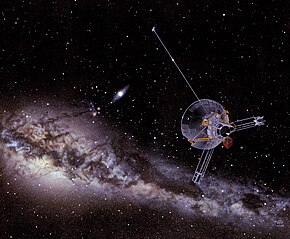Pioneer 11

An artist's impression of a Pioneer spacecraft on its way to interstellar space.
|
|
| Mission type | Planetary and heliosphere exploration |
|---|---|
| Operator | NASA / ARC |
| COSPAR ID | 1973-019A |
| SATCAT № | 6421 |
| Website |
Pioneer Project website(archived) NASA Archive page |
| Mission duration | 22 years, 5 months, 25 days |
| Spacecraft properties | |
| Manufacturer | TRW |
| Launch mass | 259 kilograms (571 lb) |
| Power | 155 watts (at launch) |
| Start of mission | |
| Launch date | April 6, 1973, 02:11:00 UTC |
| Rocket | Atlas SLV-3D Centaur-D1A Star-37E |
| Launch site | Cape Canaveral LC-36B |
| End of mission | |
| Last contact | September 30, 1995 |
| Flyby of Jupiter | |
| Closest approach | December 3, 1974 |
| Distance | 43,000 kilometers (27,000 miles) |
| Flyby of Saturn | |
| Closest approach | September 1, 1979 |
| Distance | 21,000 kilometers (13,000 miles) |
 |
|
Pioneer 11 (also known as Pioneer G) is a 259-kilogram (571 lb) robotic space probe launched by NASA on April 6, 1973 to study the asteroid belt, the environment around Jupiter and Saturn, solar wind, cosmic rays, and eventually the far reaches of the Solar System and heliosphere. It was the first probe to encounter Saturn and the second to fly through the asteroid belt and by Jupiter. Due to power constraints and the vast distance to the probe, last contact with the spacecraft was on September 30, 1995.
Approved in February 1969, Pioneer 11 and its twin probe Pioneer 10 were the first to be designed for exploring the outer Solar System. Yielding to multiple proposals throughout the 1960s, early mission objectives were defined as:
Subsequent planning for an encounter with Saturn added many more goals:
Pioneer 11 was built by TRW and managed as part of the Pioneer program by NASA Ames Research Center. A backup unit, Pioneer H, is currently on display in the "Milestones of Flight" exhibit at the National Air and Space Museum in Washington, D.C.. Many elements of the mission proved to be critical in the planning of the Voyager Program.
The Pioneer 11 bus measured 36 centimeters (14 in) deep and with six 76-centimeter-long (30 in) panels forming the hexagonal structure. The bus housed propellant to control the orientation of the probe and eight of the twelve scientific instruments. The spacecraft had a mass of 260 kilograms.
...
Wikipedia
